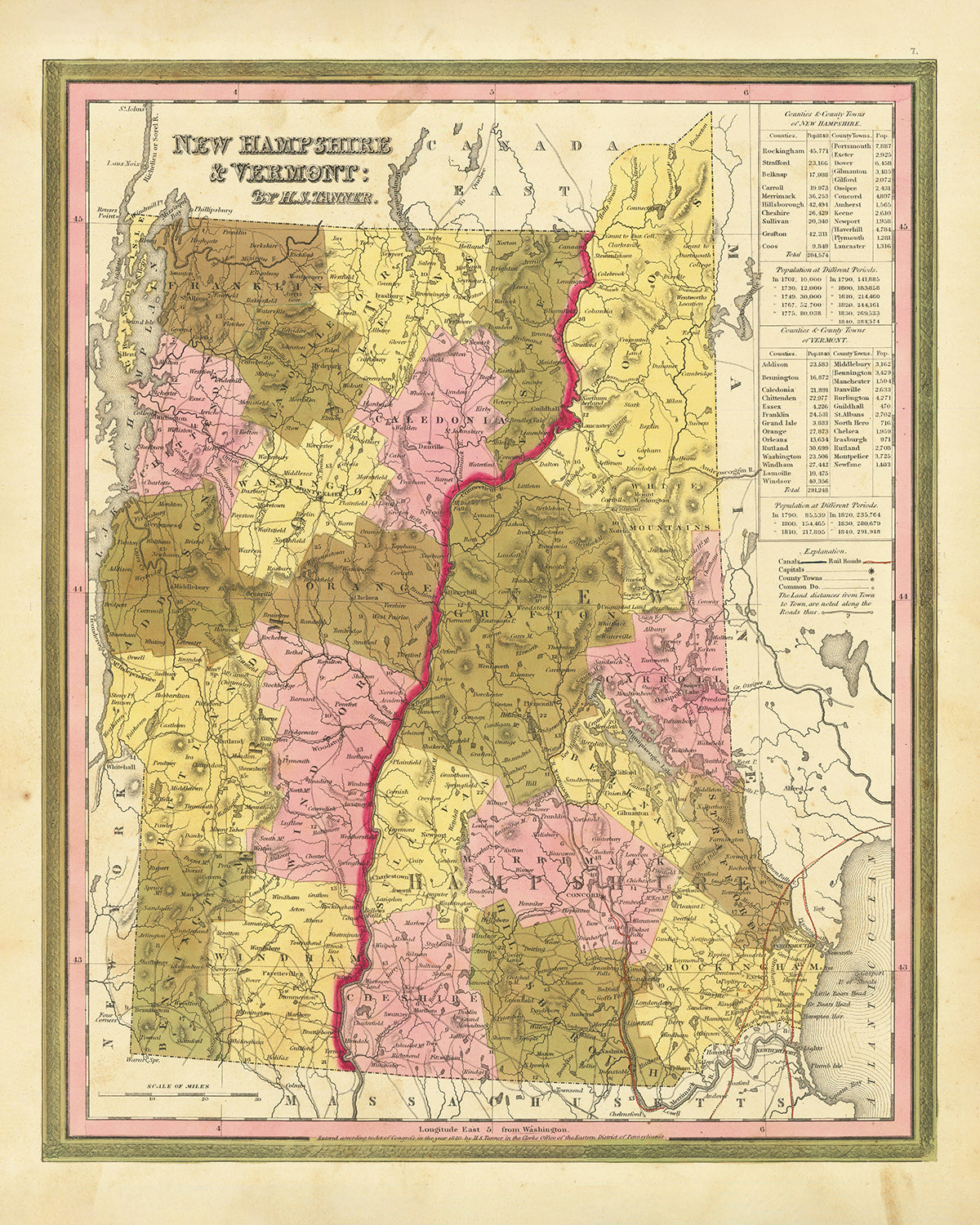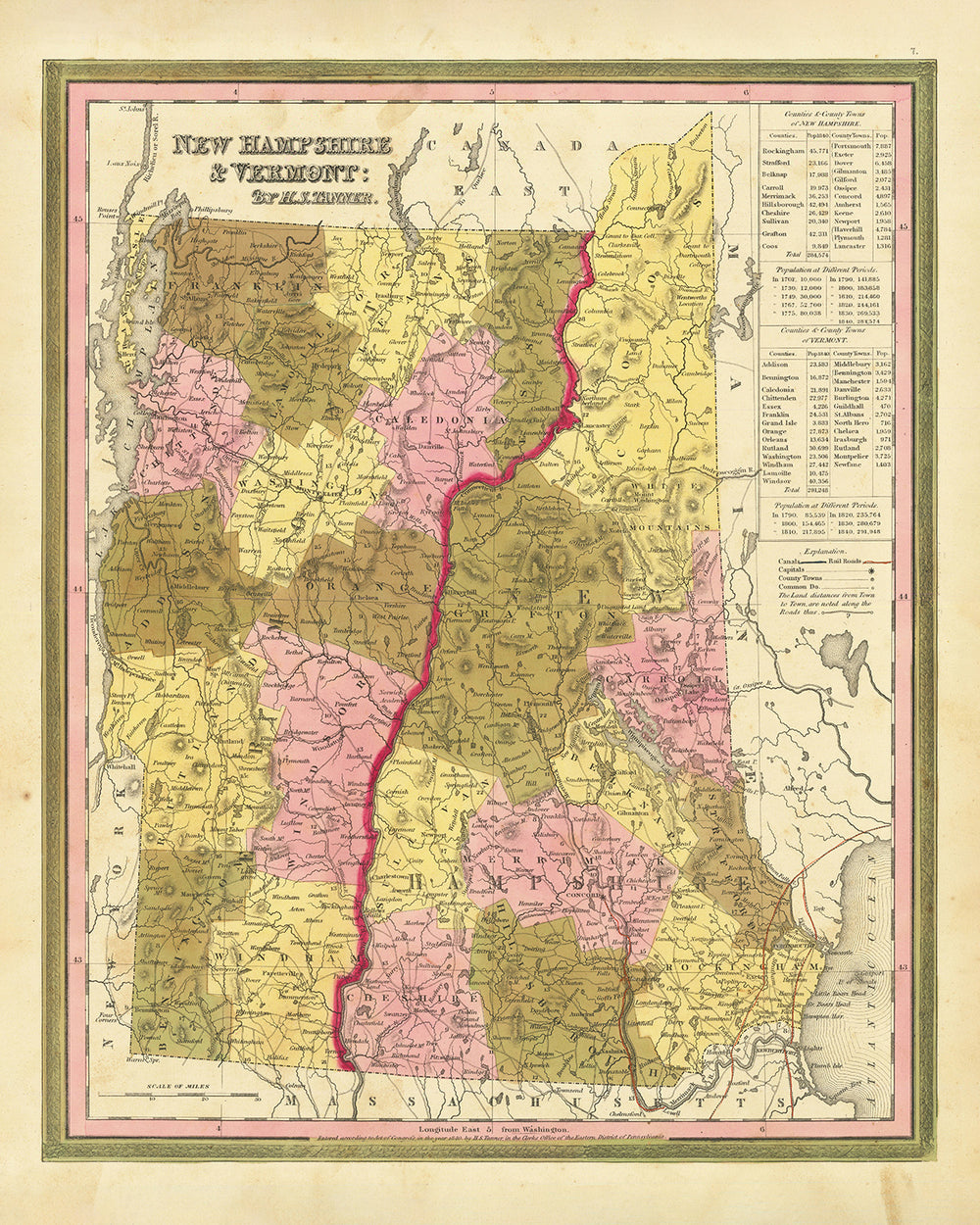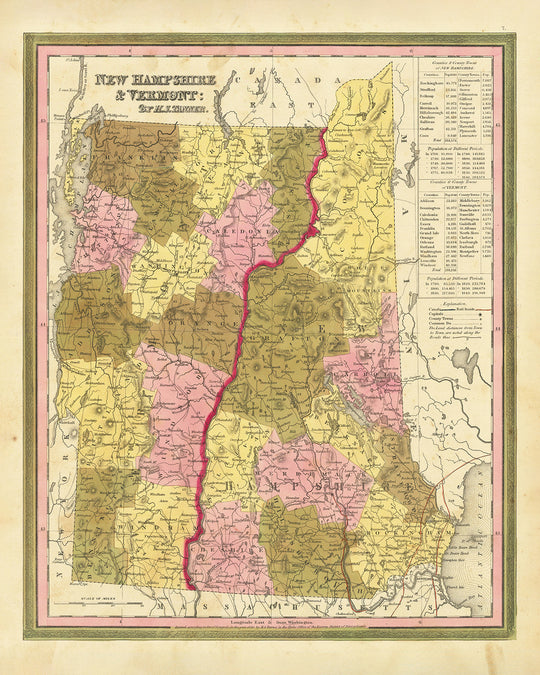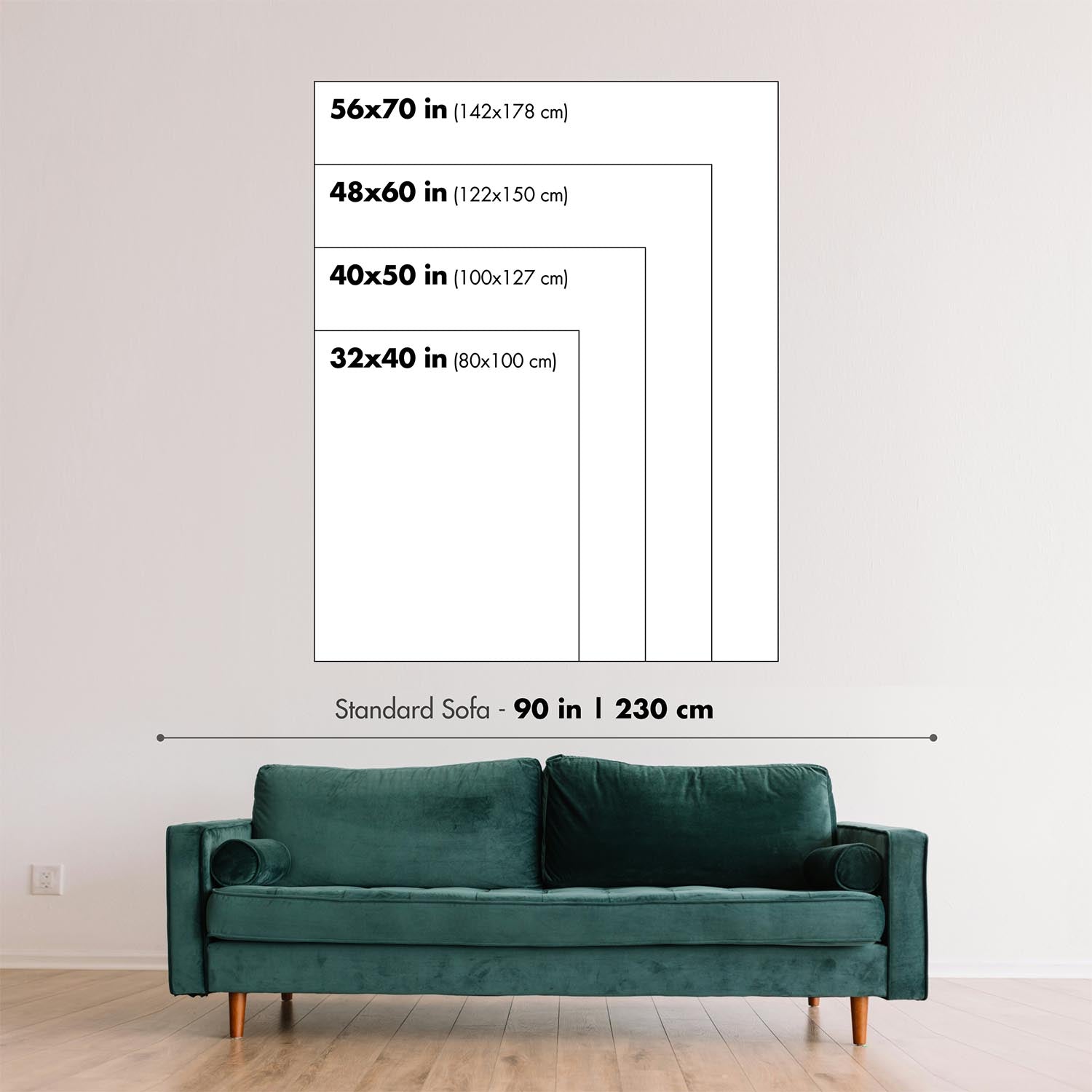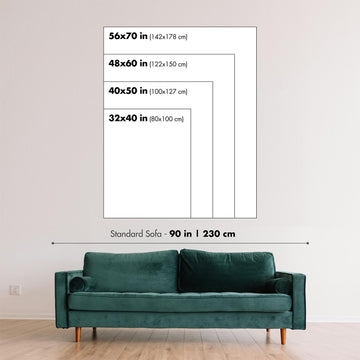- Handmade locally. No import duty or tax
- FREE Delivery by Christmas
- Love it or your money back (90 days)
- Questions? WhatsApp me any time
Own a piece of history
5,000+ 5 star reviews


Step back in time and experience a unique slice of American history with this authentic 1840 map of New Hampshire and Vermont by renowned cartographer H. S. Tanner. This exquisite piece is more than just a map – it's a window into a bygone era, showcasing towns, cities, and settlements that predate many of the region's modern metropolises. Hand-drawn with unparalleled accuracy and craftsmanship, the map allows you to trace the roots of cities you know today back to their founding names, offering a unique blend of historical context and visual appeal.
Discover the charm of the old world intricately intertwined with the beginnings of urban development. Tanner's 1840 map reflects a time before the onset of the Industrial Revolution, when communities were tightly-knit, and the topography of the land played a significant role in shaping human settlements. This map grants a rare opportunity to study the developmental trajectories of these towns and witness how they've metamorphosed over time. The period's notable boundaries, rivers, and natural phenomena that are now major tourist attractions further add to the allure of this map, making it a remarkable piece for any history or cartography enthusiast.
New Hampshire:
- Manchester (1810): New Hampshire's most populous city, originally a farming community that evolved into a textile manufacturing hub during the industrial revolution.
- Nashua (1746): Known for its significance in the cotton industry, Nashua is the second-largest city in New Hampshire.
- Concord (1725): The capital of New Hampshire, famed for its central role in the granite industry.
- Derry (1719): Known as the birthplace of the poet Robert Frost and astronaut Alan Shepard, the first American in space.
- Dover (1623): The oldest permanent settlement in New Hampshire and the 7th oldest in the United States.
- Rochester (1722): Home to a prominent shoe manufacturing industry in the 19th century.
- Portsmouth (1653): A historic seaport and popular summer tourist destination.
- Keene (1736): Home to Keene State College and Antioch University New England.
- Laconia (1746): Known for hosting the world-renowned annual Motorcycle Week.
- Lebanon (1761): Home to Dartmouth-Hitchcock Medical Center and Lebanon Municipal Airport.
Vermont:
- Burlington (1763): The most populous city in Vermont, a significant lumber port in the 19th century, and home to the University of Vermont.
- South Burlington (1865): Known for its thriving service industry, it was once part of Burlington.
- Rutland (1761): The third-largest city in Vermont, known for the production of high-quality marble.
- Colchester (1763): Home to the Saint Michael's College and several significant historical sites.
- Bennington (1749): Known for the Battle of Bennington in the American Revolutionary War.
- Brattleboro (1753): Famed for its vibrant arts scene and hosting the Strolling of the Heifers parade.
- Hartford (1761): A collection of five unique villages, including Quechee, known for its picturesque gorge.
- Barre (1780): Known as the "Granite Center of the World" for its large deposits of the stone.
- Williston (1763): Famous for the four-church historic district in its city center.
- Middlebury (1761): Home to Middlebury College, one of the top liberal arts colleges in the U.S.
Notable Landmarks and Events:
- The Connecticut River, forming much of the border between New Hampshire and Vermont, has been a major navigational route and source of hydropower.
- The White Mountains of New Hampshire, home to the state's highest peak, Mount Washington.
- The Green Mountains of Vermont, a popular destination for hiking, skiing, and other outdoor activities.
- The Dartmouth College v. Woodward case in 1819, leading to a landmark Supreme Court decision reinforcing the sanctity of contracts and significantly shaping the American public education and Native American rights movements.
- The Anti-Masonic Party's first national convention in 1830, held in Philadelphia following the mysterious disappearance of William Morgan in Batavia, New York. Vermont was a strong supporter of the party, which opposed Freemasonry.
Please double check the images to make sure that a specific town or place is shown on this map. You can also get in touch and ask us to check the map for you.
This map looks great at all sizes: 12x16in (30.5x41cm), 16x20in (40.5x51cm), 18x24in (45.5x61cm), 24x30in (61x76cm), 32x40in (81.5x102cm), 40x50in (102x127cm), 48x60in (122x153cm) and 56x70in (142x178cm), but it looks even better when printed large.
I can create beautiful, large prints of this map up to 100in (254cm). Please get in touch if you're looking for larger, customised or different framing options.
The model in the listing images is holding the 16x20in (40.5x51cm) version of this map.
The fifth listing image shows an example of my map personalisation service.
If you’re looking for something slightly different, check out my main collection of USA and North America maps.
Please contact me to check if a certain location, landmark or feature is shown on this map.
This would make a wonderful birthday, Christmas, Father's Day, work leaving, anniversary or housewarming gift for someone from the areas covered by this map.
This map is available as a giclée print on acid free archival matte paper, or you can buy it framed. The frame is a nice, simple black frame that suits most aesthetics. Please get in touch if you'd like a different frame colour or material. My frames are glazed with super-clear museum-grade acrylic (perspex/acrylite), which is significantly less reflective than glass, safer, and will always arrive in perfect condition.
This map is also available as a float framed canvas, sometimes known as a shadow gap framed canvas or canvas floater. The map is printed on artist's cotton canvas and then stretched over a handmade box frame. We then "float" the canvas inside a wooden frame, which is available in a range of colours (black, dark brown, oak, antique gold and white). This is a wonderful way to present a map without glazing in front. See some examples of float framed canvas maps and explore the differences between my different finishes.
For something truly unique, this map is also available in "Unique 3D", our trademarked process that dramatically transforms the map so that it has a wonderful sense of depth. We combine the original map with detailed topography and elevation data, so that mountains and the terrain really "pop". For more info and examples of 3D maps, check my Unique 3D page.
For most orders, delivery time is about 3 working days. Personalised and customised products take longer, as I have to do the personalisation and send it to you for approval, which usually takes 1 or 2 days.
Please note that very large framed orders usually take longer to make and deliver.
If you need your order to arrive by a certain date, please contact me before you order so that we can find the best way of making sure you get your order in time.
I print and frame maps and artwork in 23 countries around the world. This means your order will be made locally, which cuts down on delivery time and ensures that it won't be damaged during delivery. You'll never pay customs or import duty, and we'll put less CO2 into the air.
All of my maps and art prints are well packaged and sent in a rugged tube if unframed, or surrounded by foam if framed.
I try to send out all orders within 1 or 2 days of receiving your order, though some products (like face masks, mugs and tote bags) can take longer to make.
If you select Express Delivery at checkout your order we will prioritise your order and send it out by 1-day courier (Fedex, DHL, UPS, Parcelforce).
Next Day delivery is also available in some countries (US, UK, Singapore, UAE) but please try to order early in the day so that we can get it sent out on time.
My standard frame is a gallery style black ash hardwood frame. It is simple and quite modern looking. My standard frame is around 20mm (0.8in) wide.
I use super-clear acrylic (perspex/acrylite) for the frame glass. It's lighter and safer than glass - and it looks better, as the reflectivity is lower.
Six standard frame colours are available for free (black, dark brown, dark grey, oak, white and antique gold). Custom framing and mounting/matting is available if you're looking for something else.
Most maps, art and illustrations are also available as a framed canvas. We use matte (not shiny) cotton canvas, stretch it over a sustainably sourced box wood frame, and then 'float' the piece within a wood frame. The end result is quite beautiful, and there's no glazing to get in the way.
All frames are provided "ready to hang", with either a string or brackets on the back. Very large frames will have heavy duty hanging plates and/or a mounting baton. If you have any questions, please get in touch.
See some examples of my framed maps and framed canvas maps.
Alternatively, I can also supply old maps and artwork on canvas, foam board, cotton rag and other materials.
If you want to frame your map or artwork yourself, please read my size guide first.
My maps are extremely high quality reproductions of original maps.
I source original, rare maps from libraries, auction houses and private collections around the world, restore them at my London workshop, and then use specialist giclée inks and printers to create beautiful maps that look even better than the original.
My maps are printed on acid-free archival matte (not glossy) paper that feels very high quality and almost like card. In technical terms the paper weight/thickness is 10mil/200gsm. It's perfect for framing.
I print with Epson ultrachrome giclée UV fade resistant pigment inks - some of the best inks you can find.
I can also make maps on canvas, cotton rag and other exotic materials.
Learn more about The Unique Maps Co.
Map personalisation
If you're looking for the perfect anniversary or housewarming gift, I can personalise your map to make it truly unique. For example, I can add a short message, or highlight an important location, or add your family's coat of arms.
The options are almost infinite. Please see my map personalisation page for some wonderful examples of what's possible.
To order a personalised map, select "personalise your map" before adding it to your basket.
Get in touch if you're looking for more complex customisations and personalisations.
Map ageing
I have been asked hundreds of times over the years by customers if they could buy a map that looks even older.
Well, now you can, by selecting Aged before you add a map to your basket.
All the product photos you see on this page show the map in its Original form. This is what the map looks like today.
If you select Aged, I will age your map by hand, using a special and unique process developed through years of studying old maps, talking to researchers to understand the chemistry of aging paper, and of course... lots of practice!
If you're unsure, stick to the Original colour of the map. If you want something a bit darker and older looking, go for Aged.
If you are not happy with your order for any reason, contact me and I'll get it fixed ASAP, free of charge. Please see my returns and refund policy for more information.
I am very confident you will like your restored map or art print. I have been doing this since 1984. I'm a 5-star Etsy seller. I have sold tens of thousands of maps and art prints and have over 5,000 real 5-star reviews. My work has been featured in interior design magazines, on the BBC, and on the walls of dozens of 5-star hotels.
I use a unique process to restore maps and artwork that is massively time consuming and labour intensive. Hunting down the original maps and illustrations can take months. I use state of the art and eye-wateringly expensive technology to scan and restore them. As a result, I guarantee my maps and art prints are a cut above the rest. I stand by my products and will always make sure you're 100% happy with what you receive.
Almost all of my maps and art prints look amazing at large sizes (200cm, 6.5ft+) and I can frame and deliver them to you as well, via special oversized courier. Contact me to discuss your specific needs.
Or try searching for something!







